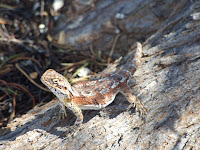Out of the red dust, red sands and the gentle red heat, and into the white sands and the cool rains …
Well after the delights of reefs, deserts, red, red dirt, and glorious weather, no sooner had we dropped below the Tropic of Capricorn and we were instantly reminded of the winter that had been. And the colours all began to change.
Travelling south towards Kalbarri the land slowly becomes increasingly covered in heath, and for those who know, heath means flowers at this time of year. There’s zillions of them – pinks, purples, yellow, whites, reds, blues dotting the whole landscape. We had our first taste of water from the skies in nearly 6 months. The further south we got, the more evident it became. We now apologise if we have tended to gloat a tad while you south-eastern readers have shivered. I think we’ve now caught up with you. However, the fun times continue for we travellers nonetheless.
The small coastal holiday town of Kalbarri Murchison River gorge that cuts through the heathlands like a lazy, confused serpent.
From there we took a beeline for Perth
As we head towards Perth Toyota
Then we hit the freeway, into Perth proper, and the delights of Karrinyup Waters Caravan Park Perth Kings Park
One day we took the fast ferry out to Rottnest Island Hebrides Islands Perth
The Woonona Mob.
 |
| Shell Beach, Francois Peron NP |
 |
| That's why it's called Shell Beach! No sand, just millions of shells. |
 |
| World Heritage Hamlin Bay. Board walk to Stromatolites. |
 |
| They still exist here due to the super saline nature of this bay. |
Kalbarri NP, Natures Window
 |
| A Fringe Lilly |
 |
| Pink Grevillea |
 |
| Zuytdore Cliffs, which was where several Dutch ships ran aground in 1600's. |
 |
| A Pink Lake! |
 |
| The Pinnicles |











No comments:
Post a Comment